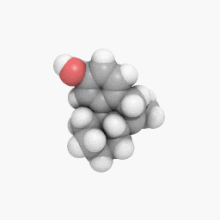Dextrorphan
 | |
 | |
| Clinical data | |
|---|---|
| Other names | DXO, Dextrorphanol |
| ATC code |
|
| Legal status | |
| Legal status |
|
| Identifiers | |
| |
JSmol) | |
| |
| |
| | |
Dextrorphan (DXO) is a
Pharmacology
Pharmacodynamics
| Site | Ki (nM) | Species | Ref |
|---|---|---|---|
| NMDAR (MK-801) |
486–906 | Rat | [4] |
| σ1 | 118–481 | Rat | [4] |
| σ2 | 11,325–15,582 | Rat | [4] |
MOR |
420 >1,000 |
Rat Human |
[4][7] |
DOR |
34,700 | Rat | [4] |
KOR |
5,950 | Rat | [4] |
| SERT | 401–484 | Rat | [4] |
| NET | ≥340 | Rat | [4] |
| DAT | >1,000 | Rat | [4] |
| 5-HT1A | >1,000 | Rat | [4] |
| 5-HT1B/1D | 54% at 1 μM | Rat | [4] |
| 5-HT2A | >1,000 | Rat | [4] |
| α1 | >1,000 | Rat | [4] |
| α2 | >1,000 | Rat | [4] |
β |
35% at 1 μM | Rat | [4] |
D2 |
>1,000 | Rat | [4] |
H1 |
95% at 1 μM | Rat | [4] |
mAChRs |
100% at 1 μM | Rat | [4] |
nAChRs |
1,300–29,600 (IC50) |
Rat | [4] |
VDSCs |
ND | ND | ND |
| Values are Ki (nM), unless otherwise noted. The smaller the value, the more strongly the drug binds to the site. | |||
The pharmacology of dextrorphan is similar to that of dextromethorphan (DXM). However, dextrorphan is much more potent as an NMDA receptor antagonist as well much less active as a serotonin reuptake inhibitor, but retains DXM's activity as a norepinephrine reuptake inhibitor.[8] It also has more affinity for the opioid receptors than dextromethorphan, significantly so at high doses.
Pharmacokinetics
Dextrorphan has a notably longer
Society and culture
Legal status
Dextrorphan was formerly a Schedule I controlled substance in the United States, but was unscheduled on October 1, 1976.[10]
Research
Dextrorphan was under development for the treatment of stroke, and reached phase II clinical trials for this indication, but development was discontinued.[11]
Environmental presence
In 2021, dextrorphan was identified in >75% of sludge samples taken from 12
See also
- Cough syrup
- Racemorphan; Levorphanol
- Noscapine
- Codeine; Pholcodine
- Dextromethorphan; Dimemorfan
- Butamirate
- Pentoxyverine
- Tipepidine
- Cloperastine
- Levocloperastine
References
- NARA. Retrieved June 26, 2023.
- PMID 9690700.
- ^ Roth BL, Driscol J. "PDSP Ki Database". Psychoactive Drug Screening Program (PDSP). University of North Carolina at Chapel Hill and the United States National Institute of Mental Health. Retrieved 14 August 2017.
- ^ PMID 26826604.
- S2CID 38476281.
- PMID 27139517.
- PMID 7815359.
- S2CID 274504.
- PMID 11602530.
- ^ DEA. "Lists of: Scheduling Actions Controlled Substances Regulated Chemicals" (PDF). Archived from the original (PDF) on 2016-04-17. Retrieved 2010-09-24.
- ^ "Dextrorphan - AdisInsight".
- PMID 33909413.
